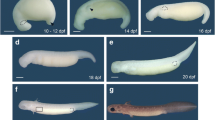Summary
Tail regions from chick embryos at three to ten days of incubation were examined by light and electron microscopy to determine what morphogenetic processes occur during transformation of the embryonic tail into the definitive type. The embryonic tail attained its maximum length (0.6 mm) between four and five days of incubation. Thereafter, the tip and base of the tail developed differently. The diameter of the tip of the tail decreased during four to six days of incubation, and many macrophages and presumptive necrotic cells appeared in this area. The tip of the tail then gradually increased in diameter during six to ten days of incubation, and changed in shape from conical to pyramidal. Only a few macrophages and presumptive necrotic cells were present during these latter stages. In most embryos during seven to ten days of incubation, the caudal end of the neural tube was cystic and small hemorrhagic zones were present in the ventral part of the tip of the tail. Near the end of this period, the ectoderm overlying the cystic portion of the neural tube often ruptured. The base of the tail increased gradually in breadth during all stages. Between six and ten days of incubation, as the leg buds elongated rapidly, the cranial part of the base of the tail became incorporated into the caudal part of the trunk. These results suggest that during morphogenesis of the tail region three morphogenetic events occur: differential growth, incorporation of part of the tail into the trunk, and cell death. The definitive tail of late incubation and posthatching stages is derived from mainly the distal portion of the base of the embryonic tail; the tip of the embryonic tail is mostly lost.
Similar content being viewed by others
References
Amprino R, Bonetti DA, Ambrose G (1969) Observations on the developmental relations between ectoderm and mesoderm of the chick embryo tail. Acta Anat Suppl 56:1–26
Boyden EA (1922) The development of the cloaca in birds, with special reference to the origin of the bursa of Fabricius, the formation of the urodeal sinus, and the regular occurence of a cloacal fenestra. Amer J Anat 30:163–202
Fallon JF (1969) Histochemistry of the posterior necrotic zone of the chick wing bud. Amer Zool 9:607
Fallon JF, Saunders JW Jr (1968) In vitro analysis of the control of cell death in a zone of prospective necrosis from the chick wing bud. Devel Biol 18:553–570
Fallon JF, Cameron J (1977) Interdigital cell death during limb development of the turtle and lizard with an interpretation of evolutionary significance. J Embryol Exp Morphol 40:285–289
Fallon JF, Simandl BK (1978) Evidence of a role for cell death in the disappearance of the embryonic human tail. Amer J Anat 152:111–130
Glücksmann A (1951) Cell deaths in normal vertebrate ontogeny. Biol Rev 26:59–86
Hamburger V, Hamilton HL (1951) A series of normal stages in the development of the chick embryo. J Morphol 88:49–92
Hendrix MJC, Morse DE (1977) Atrial septation. I. Scanning electron microscopy in the chick. Devel Biol 57:345–363
Holmdahl DE (1925) Die erste Entwicklung des Körpers bei den Vögeln und Säugetieren, inkl. dem Menschen, besonders mit Rücksicht auf die Bildung des Rückenmarks, des Zöloms und der entodermalen Kloake nebst einem Exkurs über die Entstehung der Spina bifida in der Lumbosakralregion. I. Gegenbaurs Morphol Jahrb 54:333–384
Humason GL (1972) Animal tissue techniques. Third ed., W.H. Freeman and Company, San Francisco
Karnovsky MJ (1965) A formaldehyde-glutaraldehyde fixative of high osmolality for use in electron microscopy. J Cell Biol 27:137a-138a
Kunimoto K (1918) The development and reduction of the tail and of the caudal end of the spinal cord. Carnegie Contr Embryol 26:161–203
Luft JH (1961) Improvements in epoxy resin embedding methods. J Biophys Biochem Cytol 9:409–414
Mathis J (1929) Über Bildungs-und Rückbildungserscheinungen am Schwanzende des Rückenmarkrohres bei älteren Ganskeimlingen. Z Mikr-Anat Forsch 16:331–382
Morse DE, Hendrix MJC (1980) Atrial septation. II. Formation of the foramina secunda in the chick. Devel Biol 78:25–35
Moseley HR (1947) Insulin-induced rumplessness of chickens. IV. Early embryology. J Exp Zool 105:279–316
Reynolds ES (1963) The use of lead citrate at high pH as an electron-opaque stain in electron microscopy. J Cell Biol 17:208–212
Richardson KC, Jarett L, Finke EH (1960) Embedding in epoxy resins for ultrathin sectioning in electron microscopy. Stain Technol 35:313–323
Saunders JW Jr (1966) Death in embryonic systems. Science 154:604–612
Saunders JW Jr, Fallon JF (1967) Cell death in embryonic systems. In: (M. Locke Ed) Major problems in developmental biology. Academic Press, New York. pp 289–314
Saunders JW Jr, Gasseling MT, Saunders LC (1962) Cellular death in morphogenesis of the avian wing. Devel Biol 5:147–178
Schoenwolf GC (1979) Histological and ultrastructural observations of tail bud formation in the chick embryo. Anat Rec 193:131–148
Schoenwolf GC, DeLongo J (1980) Ultrastructure of secondary neurulation in the chick embryo. Am J Anat 158:43–63
Schumacher S (1928) Ein physiologischer sekundärer hinterer Neuroporus beim Hühner-Embryo. Anat Anz 64:419–424
Van Horn JR (1971) A study of the degeneration of the tailgut in the chick embryo. Acta Morph Neerl Scand 8:234–235
Waterman RE (1977) Ultrastructure of oral (buccopharyngeal) membrane formation and rupture in the hamster. Devel Biol 58:219–229
Waterman RE, Schoenwolf GC (1980) The ultrastructure of oral (buccopharyngeal) membrane formation and rupture in the chick embryo. Anat Rec 197:441–470
Wittman KS, Krupa PL, Pesetsky J, Hamburgh M (1972) Electron microscopy and histochemistry of tail regression in the Brachyury mouse. Devel Biol 27:419–424
Zwilling E (1942) The development of dominant rumplessness in chick embryos. Genetics 27:641–656
Zwilling E (1945) The embryogeny of a recessive rumpless condition of chickens. J Exp Zool 99:79–91
Author information
Authors and Affiliations
Rights and permissions
About this article
Cite this article
Schoenwolf, G.C. Morphogenetic processes involved in the remodeling of the tail region of the chick embryo. Anat Embryol 162, 183–197 (1981). https://doi.org/10.1007/BF00306490
Accepted:
Issue Date:
DOI: https://doi.org/10.1007/BF00306490




